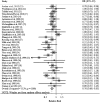Breastfeeding and ovarian cancer risk: a meta-analysis of epidemiologic studies
- PMID: 23966430
- PMCID: PMC3778857
- DOI: 10.3945/ajcn.113.062794
Breastfeeding and ovarian cancer risk: a meta-analysis of epidemiologic studies
Abstract
Background: Epidemiologic studies have yielded inconsistent findings between breastfeeding and epithelial ovarian cancer (EOC) risk.
Objective: We performed a meta-analysis to summarize available evidence of the association between breastfeeding and breastfeeding duration and EOC risk from published cohort and case-control studies.
Design: Relevant published studies were identified by a search of MEDLINE through December 2012. Two authors (T-TG and Q-JW) independently performed the eligibility evaluation and data abstraction. Study-specific RRs from individual studies were pooled by using a random-effects model, and heterogeneity and publication-bias analyses were conducted.
Results: Five prospective and 30 case-control studies were included in this analysis. The pooled RR for ever compared with never breastfeeding was 0.76 (95% CI: 0.69, 0.83), with moderate heterogeneity (Q = 69.4, P < 0.001, I(2) = 55.3%). Risk of EOC decreased by 8% for every 5-mo increase in the duration of breastfeeding (RR: 0.92; 95% CI: 0.90, 0.95). The risk reduction was similar for borderline and invasive EOC and was consistent within case-control and cohort studies.
Conclusions: Results of this meta-analysis support the hypothesis that ever breastfeeding and a longer duration of breastfeeding are associated with lower risks of EOC. Additional research is warranted to focus on the association with cancer grade and histologic subtypes of EOC.
Figures



References
-
- Jemal A, Bray F, Center MM, Ferlay J, Ward E, Forman D. Global cancer statistics. CA Cancer J Clin 2011;61:69–90 - PubMed
-
- Siegel R, Naishadham D, Jemal A. Cancer statistics, 2012. CA Cancer J Clin 2012;62:10–29 - PubMed
-
- US Preventive Services Task Force Guide to clinical preventive services. 2nd ed. Washington, DC: US Department of Health and Human Services, Office of Disease Prevention and Health Promotion, 1996
-
- Danforth KN, Tworoger SS, Hecht JL, Rosner BA, Colditz GA, Hankinson SE. Breastfeeding and risk of ovarian cancer in two prospective cohorts. Cancer Causes Control 2007;18:517–23 - PubMed
-
- Fathalla MF. Incessant ovulation–a factor in ovarian neoplasia? Lancet 1971;2:163. - PubMed
Publication types
MeSH terms
Grants and funding
LinkOut - more resources
Full Text Sources
Other Literature Sources
Medical
Miscellaneous

